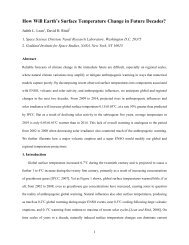When the Heliospheric Current Sheet [Figure 1] - Leif and Vera ...
When the Heliospheric Current Sheet [Figure 1] - Leif and Vera ...
When the Heliospheric Current Sheet [Figure 1] - Leif and Vera ...
Create successful ePaper yourself
Turn your PDF publications into a flip-book with our unique Google optimized e-Paper software.
<strong>When</strong> <strong>the</strong> <strong>Heliospheric</strong> <strong>Current</strong> <strong>Sheet</strong> [<strong>Figure</strong> 1] overtakes <strong>the</strong> Earth (or a spacecraft) anabrupt change of magnetic polarity (away from <strong>the</strong> Sun or towards <strong>the</strong> Sun) is observed:a Sector Boundary (SB).<strong>Figure</strong> 1. The warped<strong>Heliospheric</strong> <strong>Current</strong><strong>Sheet</strong> in <strong>the</strong> inner solarsystem (inside of 6 AU).The surface divides <strong>the</strong>heliospheric magneticfield into twp regionswith oppositely directedfield lines. The surface ishere shown for a 4-sectorstructure at a timeintermediate betweensolar minimum <strong>and</strong> solarmaximum.A SB (observed at Earth) maps back to a magnetic neutral line at central meridian in <strong>the</strong>corona <strong>and</strong> also in <strong>the</strong> originating photospheric magnetic field about 4.5 days earlier,being <strong>the</strong> transit time of <strong>the</strong> solar wind. The latter neutral line is on average meridional,i.e. along longitudes.Active regions have a photospheric neutral line too. The neutral line divides oppositepolarities in opposite hemispheres (Hale’s law). The portion [in a hemisphere] of a SBneutral line where <strong>the</strong> polarity change is <strong>the</strong> same as that for an active region was called aHale Boundary by Svalgaard <strong>and</strong> Wilcox [ref], see <strong>Figure</strong> 2:<strong>Figure</strong> 2. Schematic of <strong>the</strong>solar disk showing <strong>the</strong> portionof a SB that is designated aHale boundary, that portion ofa sector boundary that islocated in <strong>the</strong> solar hemispherein which <strong>the</strong> change ofmagnetic polarity across <strong>the</strong>SB is <strong>the</strong> same as <strong>the</strong> changeof magnetic polarity from apreceding spot to a followingspot. The spot polarities shownin <strong>the</strong> small circles correspondto even-numbered cycles.
They showed that above a Hale portion of a SB, <strong>the</strong> green corona has a maximum inbrightness, while above a non-Hale boundary, <strong>the</strong> green corona has minimum brightness.Using synoptic maps of <strong>the</strong> magnitude of <strong>the</strong> photospheric field strength observed at Mt.Wilson Observatory during 1967 to 1973 it was also found that <strong>the</strong> unsigned magneticfield flux is at a maximum at <strong>the</strong> Hale boundary, in concert with <strong>the</strong> green coronabrightness.We have recently repeated <strong>the</strong> analysis using all available date from <strong>the</strong> Wilcox SolarObservatory (WSO). We superpose full-disk magnetograms from <strong>the</strong> times where a SBwas at [i.e. within a day] central meridian. We can take advantage of <strong>the</strong> polarity changes<strong>and</strong> treat (-,+) boundaries as (+,-) boundaries by reversing <strong>the</strong> sign of <strong>the</strong> magnetic field,<strong>and</strong> of <strong>the</strong> Hale magnetic cycle by reversing hemispheres between cycles to construct a‘nominal’ magnetogram for a (+,-) Hale boundary averaged over solar cycles 21-24,<strong>Figure</strong> 3.<strong>Figure</strong> 3. The average magnetograms for a nominal (+,-) Hale boundaryduring solar cycle 23. 910 magnetograms superposed on 765 SBs using <strong>the</strong>WSO observations 1976-2010. Some data has been mirrored <strong>and</strong> signreversedas described in <strong>the</strong> text to reduce all data to <strong>the</strong> situation for cycle23. The Hale portion of <strong>the</strong> sector boundary is marked by <strong>the</strong> semitransparentbar. Left <strong>Figure</strong> shows <strong>the</strong> average signed field, while <strong>the</strong> righth<strong>and</strong><strong>Figure</strong> shows <strong>the</strong> average unsigned [total] field.It is now evident, that on average, what causes <strong>the</strong> ‘warps’ in <strong>the</strong> current sheet (anmdhence <strong>the</strong> SB at Earth) originates strongly from one hemisphere, namely that which has<strong>the</strong> Hale boundary (<strong>the</strong> Nor<strong>the</strong>rn in <strong>Figure</strong> 3). Coronal holes are often found co-locatedwith <strong>the</strong> interiors of <strong>the</strong> sectors.One important (<strong>the</strong> only?) source of <strong>the</strong> open flux is dispersing flux from active regionswith strong magnetic fields so we expect <strong>the</strong> concentration of total flux at <strong>the</strong> Haleboundary as shown in <strong>the</strong> right-h<strong>and</strong> side of <strong>Figure</strong> 3. The closed field lines associated
with <strong>the</strong> active regions would trap coronal material, explaining <strong>the</strong> enhanced brightnessof <strong>the</strong> green corona at Hale boundaries.We would also expect flares <strong>and</strong> microflares to preferentially occur near <strong>the</strong> Haleboundary. Using <strong>the</strong> RHESSI flare list covering <strong>the</strong> interval March 2002 to March 2008(wholly within cycle 23) we find, indeed, that to be <strong>the</strong> case, <strong>Figure</strong> 4:<strong>Figure</strong> 4. Distribution of RHESSI flares on <strong>the</strong> day a SB was mapped back tocentral meridian for part of solar cycle 23, March 2002 to March 2008. Thered boxes show where flares are expected based on association with strongmagnetic fields: at <strong>the</strong> Hale boundary. The circles show that hardly any flaresoccur near a non-Hale boundary.GOES flares for May 1996 to January 2009 (cycle 23) show <strong>the</strong> same distribution, albeitwith much poorer statistics because of <strong>the</strong> smaller number of cases:<strong>Figure</strong> 5. As <strong>Figure</strong> 4, but for <strong>the</strong> GOES spacecraft, May 1996 to Jan. 2009.
We can quantify <strong>the</strong> asymmetry by integrating <strong>the</strong> count in longitude between 30 degreeson ei<strong>the</strong>r side of Central Meridian, <strong>Figure</strong> 6:<strong>Figure</strong> 6. Number of flare events within ±30 degrees of Central Meridian as afunction of latitude.The correlation between <strong>the</strong> polarity of <strong>the</strong> solar Mean Field (over a smaller disk centeredon <strong>the</strong> sun-Earth point) <strong>and</strong> <strong>the</strong> polarity of <strong>the</strong> <strong>Heliospheric</strong> Magnetic Field maximizesfor a disk radius of 0.5 solar radius, justifying <strong>the</strong> choice of 30 degrees on ei<strong>the</strong>r side ofCentral Meridian.In a sense, all this is trivial, i.e. just what we would expect, were it not for <strong>the</strong> fact that <strong>the</strong>solar sector structure is very organized <strong>and</strong> long lived, indicating that solar activity is notr<strong>and</strong>om, but enjoys <strong>the</strong> same degree of spatial <strong>and</strong> temporal structure.


![When the Heliospheric Current Sheet [Figure 1] - Leif and Vera ...](https://img.yumpu.com/51383897/1/500x640/when-the-heliospheric-current-sheet-figure-1-leif-and-vera-.jpg)


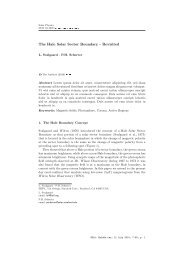
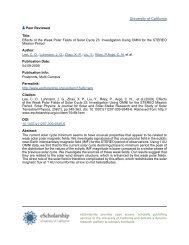

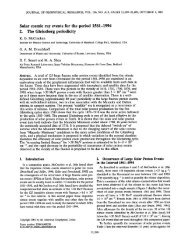
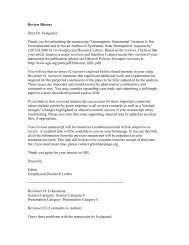

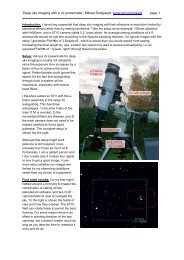
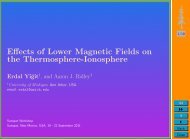
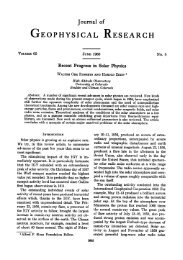
![The sum of two COSine waves is equal to [twice] the product of two ...](https://img.yumpu.com/32653111/1/190x245/the-sum-of-two-cosine-waves-is-equal-to-twice-the-product-of-two-.jpg?quality=85)
